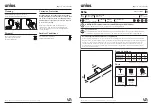
20
Troubleshooting and Testing
4.3
System Diagnostics
4.3.1
WABCO TOOLBOX™ Software
Use WABCO’s PC-based diagnostic program, TOOLBOX™ Software, to diagnose SmartTrac™ hydraulic
ABS faults and trouble codes. The software runs in Windows
®
XP, Vista, Windows
®
7, 8 and 10. It is used
to display system faults, wheel speed data, test individual components, verify installation wiring, enable and
disable system functions, view counters and more.
The TOOLBOX™ Software is available for purchase at https://wabco.snapon.com. Follow the instruction
and correctly install the software. Once you have TOOLBOX™ Software installed on your computer, follow
the on-screen repair information to make the necessary repairs or replacements. See the following section
for basic fault identifying and system testing instructions.
A J1939 cable and USB vehicle communication interface adapter are required to connect the
PC to the J1939 vehicle bus while performing diagnostics.
For complete instructions for using this program, refer to the User’s Manual at
https://zf.com/cvliterature
under Service and Support, TOOLBOX™ Software. Contact the
WABCO Customer Care Center at 855-228-3203 for information about TOOLBOX™ Software.
4.3.2
SmartTrac™ Hydraulic ABS Main Screen and Menus
Select Hydraulic ABS from the TOOLBOX™ Software Main Menu. TOOLBOX™ Software will read and
identify the type of ECU being used and displays the SmartTrac Hydraulic screen.
4.3.2.1
Main Screen
This screen provides product information (ECU part number, serial number, software version, etc.),
component data, wheel sensor data, sensor status and pull-down menu selections.
ECU information is read once from the ECU and does not change. All other information (e.g.,
wheel sensors, voltages and fault information) is read and updated continuously.
4.3.2.2
Pull-Down Menu Selections
System
Adapter Selection: Select the adapter used to interface between the vehicle, the communication
connector and the laptop. The protocol for SmartTrac™ hydraulic is J1939.
Exit:
Exit the program.
Display
Diagnostic Trouble Codes:
Displays the faults and trouble codes, along with SPN and FMI numbers that
can be referenced in the system reaction codes and repair instructions listed in Appendix.
















































